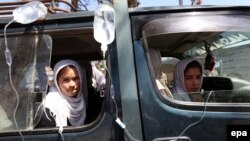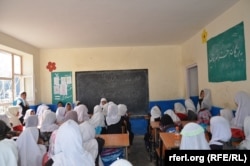Efforts by Kabul and international donors to educate girls in Afghanistan have “significantly faltered in recent years,” according to Human Rights Watch (HRW).
Sixteen years after the U.S.-led military intervention in Afghanistan ousted the Taliban from power, an estimated two-thirds of Afghan girls do not attend school, HRW said in a new report released on October 17.
The 132-page report says efforts to educate girls have faltered as security in the country worsens and international donors disengage.
The report -- titled I Won’t Be A Doctor, And One Day You’ll Be Sick: Girls’ Access To Education In Afghanistan -- is based on 249 interviews with girls aged 11 to 18 from four provinces.
More girls are attending school in Afghanistan today than under the Taliban, but the Western-backed Afghan government is far from reaching its stated goal of educating all of them.
According to the government, 3.5 million children are out of school and 85 percent of them are girls. Only 37 percent of adolescent girls are literate, compared to 66 percent of adolescent boys.
The obstacles girls face in Afghanistan to get an education are many, the HRW report says.
In a country where co-ed education is nearly unheard of, Kabul provides fewer schools for girls than boys at both the elementary and high-school levels.
Fewer than 20 percent of teachers are female in more than half of Afghanistan’s provinces, HRW explains, creating a barrier for the many girls from families who won’t allow them to be taught by a male.
Many girls are forced to remain at home, HRW says, “due to discriminatory attitudes that do not value or permit their education.”
With one-third of girls marrying before 18, many are compelled to drop out of school.
Despite the obstacles, many Afghan families are doing all they can to educate their daughters, the HRW report highlights.
HRW interviewed families that moved across cities and even the country to find a school for their daughters, as well as others that separated to enable girls to study.
In some cases, older brothers traveled to Iran to work illegally to pay school costs for their younger sisters back home.
Even when school is free, there are other costs families face in sending their kids to school. And if forced by financial constraints, many families opt to send their sons instead of their daughters to school.
About one-quarter of Afghan children work to help their families survive desperate poverty, and many girls weave, embroider, beg, or pick garbage rather than study.
The Taliban and other insurgents now control or contest more than 40 percent of Afghanistan’s districts. Fighting between Taliban and government forces has driven thousands of families from their homes and more than 1 million Afghans are internally displaced.
In areas under their control, the Taliban often limits girls to only a few years of schooling or bans them from education altogether.
In contested areas, girls seeking to attend school face heightened security threats. The conflict has been accompanied by lawlessness, as militias and criminal gangs have proliferated, and girls face threats including sexual harassment, kidnapping, and acid attacks, as well as targeted attacks and threats against girls’ education, the HRW report said.
International donors also come in for criticism. HRW applauded efforts by Kabul and donors to develop "community-based education,” which is a network of classes, often held in homes, that allow children, particularly girls, to access education in communities far from a government school.
But HRW pointed out that these specialized classes, funded by donors and implemented by NGOs, remain outside the government school system and are vulnerable to the vagaries of NGO funding.






